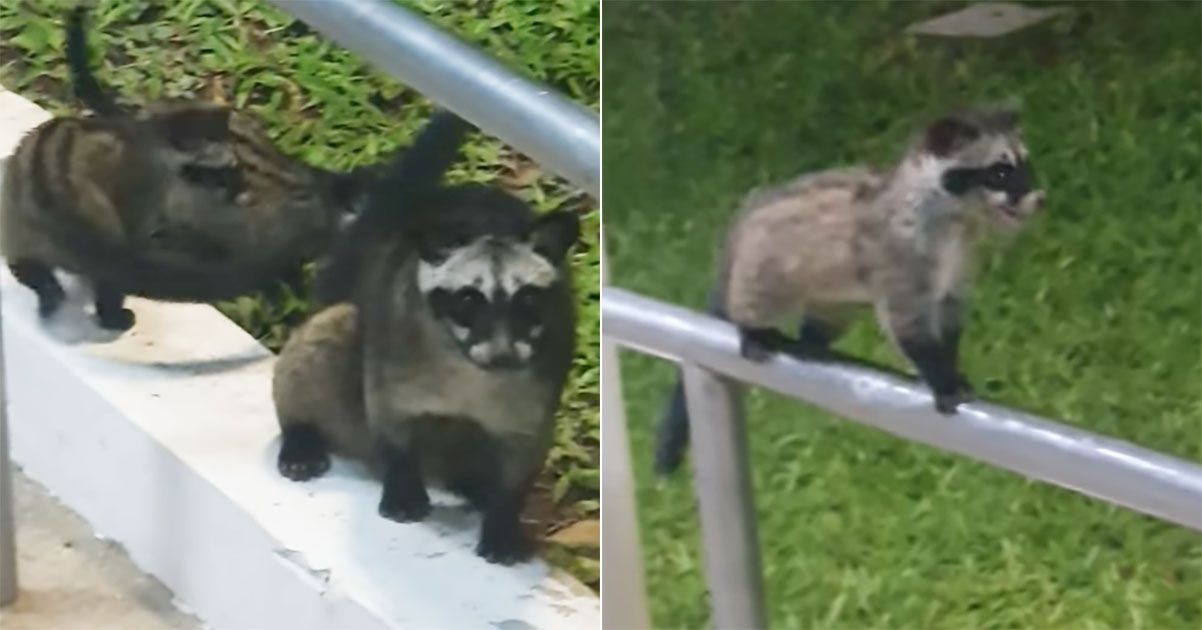Civets are seldom seen in broad daylight, much less in urban areas with humans and heavy footfall.
Which is why, it is always fascinating to see not just one civet, but a parent with a pair of juvenile offspring in tow.
Video of 3 civets
That was what one resident in an estate in a neighbourhood in Singapore witnessed recently.
In a 2-minute video posted in the Singapore Wildlife Sightings Facebook group, an adult civet could be seen with two smaller civets on the grass patch beside the concrete walkway.
The exact location was not revealed.Exploring
According to a local blog post on civets, mother civets are known to move her young in response to their habitat being disturbed by humans or natural causes.
And juvenile civets can sometimes be separated from the parent during this process, as the younger ones might wander off and get lost.
In this instance, the civets stuck around together and could be seen exploring their surroundings.
At one point, one of the juvenile civets climbed up the railing and remained on it for a short while.
The adult civet then jumped onto the railing to nudge the juvenile civet off.
It then went back into the forested area, leaving one of the juvenile civets behind on the grass patch, as it appeared reluctant to leave.
The juvenile civet subsequently followed the other two civets into the forested area via a small clearing.
Dos and don'ts
However, due to their shy nature and nocturnal nature, civets don't appear frequently in public and people might not know what to do when they do see one.
If you happen to see a civet, here is some advice from the National Parks Board (NParks): Do keep a safe distance and observe them from afar.
Like other wild animals, civets are shy and will typically stay out of sight.
Do not make the civet feel cornered or provoked as that can cause them to attack you in self-defence.
If you find civets near the vicinity of your property, do keep away any leftover cat or dog food.
If you see baby civets on your property, do not touch them as that might prevent the mother civet from picking them up resulting in the babies being abandoned by their mother.
The mother civet will respond to its babies when it's nearby.
Two to three months after birth, the civets will follow their mother out to forage.
If you need help, you can call the 24-hour NParks' Animal Response Centre hotline at 1800 476 1600.
Or you can contact the 24-hour Acres wildlife rescue hotline at 9783 7782.
Not a cat
Common palm civets are known as Toddy cats or Musang (in Malay).
They are not cats even though they are often labelled as such.
Civets are actually more related to hyenas and mongooses.
Common palm civets are one of the four types of civets that can be found in Singapore.
They can be found in both forested and urban areas, usually occupying tree cavities.
Being nocturnal, they are usually active after dark between 6pm and 4am, according to wiki.nus.
Important seed disperser
Common palm civets have a mixed diet that consists of fruits, leaves, insects, small mammals and reptiles.
Some of their favourite food found in the wild here include mangoes, bananas, chikus, fruits from the Fishtail Palm and seed pods from the Rain Tree.
Because of their diet and ability to travel further than other animals, they are important seed dispersers in the wild.
Some seeds can only germinate after passing through the digestive system of the civets.
This is why civets play an important role in restoring degraded forests in Singapore.
Top photos via
If you like what you read, follow us on Facebook, Instagram, Twitter and Telegram to get the latest updates.



